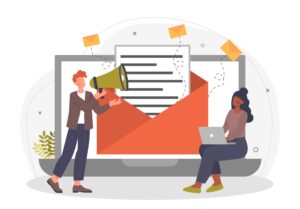
How to Write Strong Email Copy

Our Favorite Tips For Writing Effective Email Copy
- Use verbs – Let readers know exactly what they can do from the email. After you draft a subject line, review it and find the verb. There should be a next step that is obvious from the subject line or the first copy in the email. This is also a good way for readers to see the value in the email they are about to open.
- Personalize as much as possible – Research shows that highly segmented and targeted emails have better response rates. In fact, some of the most effective strategies for email are subscriber segmentation, message personalization, and automated campaigns. Today’s customization goes far beyond just using the recipient’s first name in the introduction. Look for ways to make your email more personal, such as mentioning specific past engagements or attorneys. As you break down different emails, make sure to change the subject line and intro copy appropriately.
- Seek clarity first, “catchiness” second – When you draft subject lines, make sure that the email content is made very clear. Only then should you look for ways to punch it up and get more witty. Never sacrifice clarity for trying to be more attention-getting. People’s attention will come when they see that you are offering something of value in the email.
- Align subject lines and email content – Everything from your subject line to email copy to CTA to landing pages should be in sync. Whatever is promised in the subject line should be present in the email – and whatever is discussed in the email should lead to a landing page that makes next steps easy. Without this alignment, you can expect click-through rates to drop. People will quickly see that they aren’t finding what piqued their interest and move along.
- Help readers see the relevancy – Use the beginning of the email to explain why you’re reaching out to them and why you’re qualified to discuss the topic of the email. This is particularly important for emails like a welcome series or an email targeted toward someone who hasn’t been opening emails lately.
- Write in second person – Use words like “you” and “yours” rather than “us” or “ours”. This orients the copy toward the reader, not the sender. By talking about the client, not the brand, you can better focus on benefits and what matters to them.
- Talk about benefits, not services – Related to the point above, emails should help recipients to learn more about what you can do for them. Too many emails only explain a certain product, service, or feature – and not why readers should care. What’s the value to them? What is the benefit of engaging with your firm? Peace of mind? Compliance guarantees? Lower FTE costs? Make sure to share not just what you’re offering, but the benefits that clients can expect by engaging with your firm.
- Be concise – This is a universal best practice that has been advised for years, and for good reason. People scan, they don’t read in-depth. Longer emails make it more difficult for people to actually absorb what you’re saying in your email. Get right to the point and then add a few supporting points. What action is your email intended to drive? Make sure that is crystal clear and then offer limited information supporting that action. Having a single call to action in an email leads to higher response rates, so narrow down your focus and make that obvious.
- Be human – Email can be a powerful channel for letting your firms’ brand show through. People feel more drawn to individuals they relate to, and you can use email to build this trust if you show a little personality. Look for ways to delight your readers as well as inform them. Don’t be afraid to send an occasional email that’s a little cheeky or poking fun at a current pop culture trend. It will endear readers to you.
- Calls-to-action should be actionable – Sounds obvious, but you’d be surprised how often this detail gets overlooked. Your CTA should be extremely easy to identify upon scanning the email – people shouldn’t have to scroll and dig for it. Use features like buttons or bright colors to draw the eye to your CTA. If you are trying to keep your email really simple and streamlined, make sure to use anchor text in your CTA. Tell your reader exactly what you want them to do, and keep one CTA primary. A CTA doesn’t have to be “Call us today!” – it can be anything from subscribing to your newsletter to attending your next webinar. Every email should have an actionable goal in mind.
Related: Turning Digital into Dollars
Takeaway:
Impactful email marketing is a true science, but one that successful legal marketers have perfected (or at least, continue to improve). Crafting email copy that people actually open and read will strengthen relationships, generate more leads, and support all of your other marketing activities. If you’re stumped, reach out to our email marketing experts. We help firms of all sizes incorporate compelling email into a comprehensive marketing strategy.
Are you ready to get started generating new, qualified leads?
Contact us to get started and let us help you energize your digital marketing and business development efforts.
Contact Us
